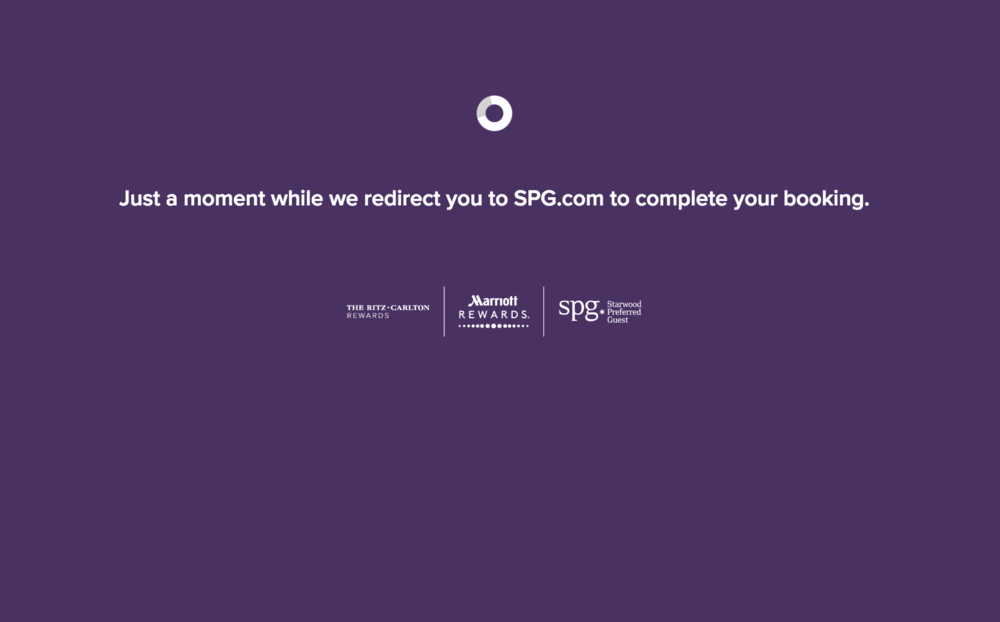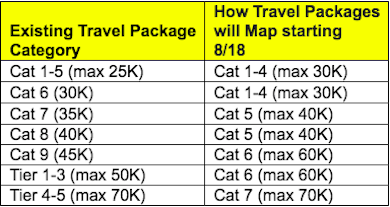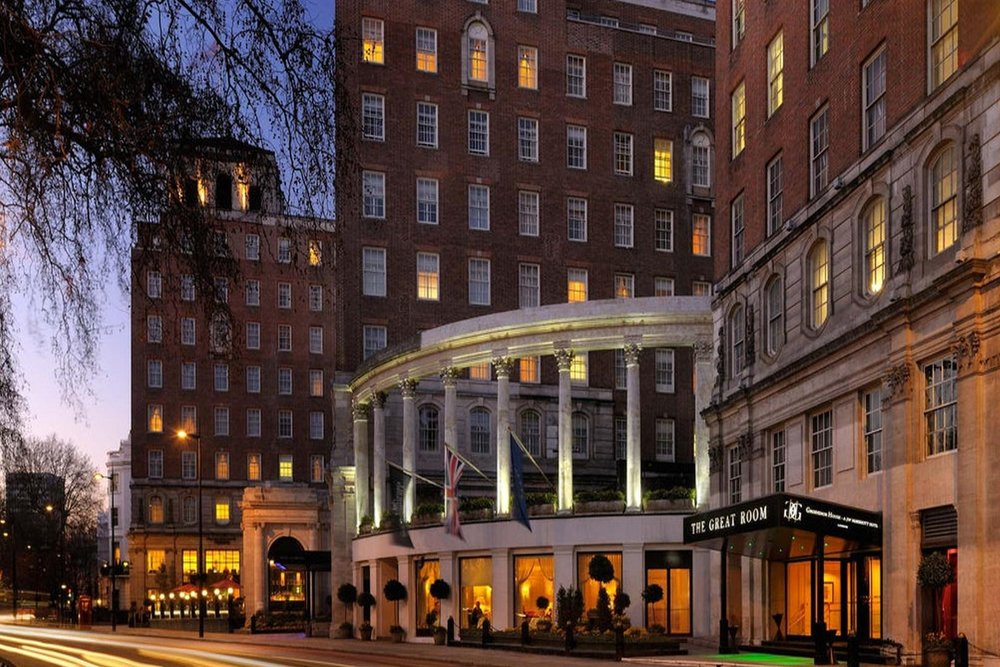Time flies, doesn’t it? I can scarcely believe that we’re already moving into October 2018, and that one of the most highly anticipated landmarks in the Miles & Points community – the coming together of Marriott Rewards and Starwood Preferred Guest – has already come and gone.
In fact, it’s been more than month since the official transition date of August 18, 2018, so I thought now would be a good time to take stock of what’s happened since. Has the merger succeeded operationally? What kinks remain to be ironed out? And what golden opportunities are there for us to maximize? Let’s assess the aftermath of the merger as things stand so far.
In This Post
Elite Status
As of August 2018, our elite nights across the SPG and Marriott programs ought to have been combined into one, and the new number of nights would be subject to a new elite status program, which works as follows:
Status level | Required nights | Credit cards |
Silver | 10 nights | Marriott Bonvoy American Express Card (US) Chase Marriott Bonvoy Boundless Card (US) Chase Marriott Bonvoy Bold Card (US) |
Gold | 25 nights | Chase Ritz-Carlton Card (US) |
Platinum | 50 nights | |
Titanium | 75 nights | |
Ambassador | 100 nights + $23,000 (USD) spending |
Notably, the old Gold and Platinum Elite levels do not map directly into the new program; instead, Marriott Gold in the old program, which required 50 nights to qualify, is essentially equivalent to Platinum Elite in the new scheme, while the old Marriott Platinum at 75 nights is equivalent to Platinum Premier.
Indeed, when I look at my own Marriott account, I see that all my 2018 nights are visible in my Account Activity and I have no stays outstanding. My seven nights at the JW Marriott Rio de Janeiro had never properly credited, but that was fixed by a quick phone call to the Platinum line a few weeks ago, so I’d urge you to do the same if you still have nights missing from previous stays.
With the transition, another change that has impacted many members of the program is that the American Express Platinum Card and Business Platinum Card no longer provide lounge access and free breakfast at Marriott hotels, because of the changes to Gold Elite status as outlined above. There are a few factors that mitigate this loss:
-
15 elite nights should be credited to your account in 2019 if you hold any of the US-issued SPG or Marriott credit cards, which should help greatly in achieving the 50-night threshold for Platinum Elite status; apparently this will be true for the Canadian cards as well, although we’ve yet to hear anything official on that
-
The Platinum status challenge remains within reach, and you can call Marriott to enrol. Once enrolled, 16 paid qualifying nights in three months will get you Platinum Elite status.
Verdict: Very good. Elite nights have been handled quite well during the transition, with most bugs having been ironed out in the first week or so after the merger. If you’re still missing elite nights from previous stays, give Marriott a call in order to sort it out.
Points Redemptions
The ability to redeem points at the new award levels has been working mostly fine; however, it’s noteworthy that the back-end systems haven’t been integrated yet. If you’re looking to book hotels that were previously under the Marriott umbrella, you shouldn’t notice anything different, whereas booking legacy SPG properties will bring you to an intermediate screen that still looks like the old SPG system.
If you were trying to book over the phone, you’d notice that the Marriott and SPG reservations agents remain separate, and you need to be transferred between the two call centres in order to each respective program’s hotels.

As a direct result of this, there are now quite a few regards in which Marriott has over-promised and under-delivered – for example, Marriott had indicated that the popular Points Advance feature (i.e., the ability to make reservations without having the points in your account yet) would remain in the new program; however, this isn’t yet possible with legacy SPG properties because they’re still being processed on a different reservation system.
(In fact, over-promising and under-delivering has been something of a theme in the aftermath of this merger. It’s disappointing, frankly, after we were all so encouraged by the strength of the new program when it was announced.)
The latest timelines we have from various sources is that SPG hotels should be fully integrated into the Marriott back-end by December or perhaps even early January 2019. That’s a disappointing timeline and makes you wonder why Marriott opted for a mid-year merger in the first place when a year-end merger would have made a whole lot more sense.
Verdict: Good. While you can now redeem your points at virtually all properties without issues, the delay in transitioning SPG properties onto the Marriott back-end has resulted in certain lingering issues which still haven’t been fixed.
Travel Packages
You weren’t truly obsessed with Miles & Points if you weren’t following the Marriott Travel Packages saga in the months leading up to August. No one knew what was going to happen to existing packages, and when the conversion method was finally announced, it was met with vitriol and anger from virtually every member who held a Travel Package.
As a reminder, this was the conversion chart that was originally revealed on August 19, the day after the merger:

Since then, Marriott has revealed via FlyerTalk representatives that members who held Old Category 6 and Old Category 8 certificates would indeed be eligible for a refund of 30,000 points, and that members could still choose to cash in their legacy certificates for the old surrender values.
In practice, though, the execution of the Travel Package conversion has been a debacle, to say the least.
No certificates were converted automatically – you have to call in to convert them with an agent who might or might not know how to do it; otherwise, the old certificates just sit in your account, unable to be used. As it turns out, most agents were still following the original directive that the old certificates couldn’t be touched until September 18, meaning that you often had to hang up and call again multiple times to get this handled.
To make matters worse, there were many anecdotes of certificates being lost in the process, or being involuntarily refunded for the paltry surrender value. These issues are indeed still ongoing and Marriott seems to have no interest in fixing them.
And of course, given that SPG hotels still haven’t been brought over to the Marriott back-end, we still can’t use our existing 7-night hotel certificates on legacy SPG properties. This is, again, bitterly disappointing in light of the fact that everything was meant to be “all under one roof” as of August 18.
On the bright side, there are also reports on the FlyerTalk thread that amidst the confusion, some members were able to upgrade their certificates to higher categories, which wasn’t supposed to be allowed. Other members were given hefty amounts of goodwill points for their troubles in converting their 7-night instruments. It’s good to see that at least a few enterprising members were able to get a positive outcome out of this mess.
Verdict: Bad. The handling of existing Travel Packages has been nothing short of an embarrassment. I get the impression that Marriott is somewhat annoyed that the Travel Package sweet spot had existed for so long, and is looking to use obfuscation tactics to bring about as much breakage as possible with regards to the outstanding certificates (i.e., getting people to use them for as low a value as possible).
That’s no way to treat any member of the program, let alone those who would’ve collected the highest volumes of points to redeem for these packages.
New Category 8 Hotels
One of the most well-documented sweet spots in the new program, as it currently stands, is the ability to redeem 60,000 points for a free night at some of the world’s best hotels – the ones that will be changing from Category 7 to the new Category 8 in early 2019.
Once Category 8 and peak/off-peak pricing kicks in, these hotels could go for as much as 100,000 points a night, so the opportunity lock in a stay for just 60,000 points a night represents a great deal. Remember, you can use this for stays throughout 2019 as well – as long as you book before early 2019, you’ll secure the lower rate.
In terms of how this deal has played out in real life, the ability to book free nights for 60,000 point seems to vary dramatically between the various luxury properties out there. Some hotels, like the St. Regis New York, can be booked throughout the end of schedule at the discounted rate with no issues. Others, like the Al Maha Desert Resort & Spa near Dubai, can’t be booked via the website but can easily be booked via the Marriott app. And yet other hotels, like the St. Regis Bora Bora, are definitely playing games with the award inventory and blocking people from redeeming points at the reduced rate.

Al Maha, a Luxury Collection Desert Resort & Spa, Dubai
It shouldn’t come as a surprise that the management teams of many of these luxury hotels – especially the legacy SPG ones – aren’t exactly thrilled about this redemption opportunity. They’d much rather people pay the cash rate of $1,500+ per night than redeem 60,000 points, after all.
But part of the appeal of the new Marriott program was that it would retain the policy of no blackout dates, meaning that as long as a standard room was available at the property, it’d be bookable with points. It’s disappointing to see hotel management teams shirk those responsibilities when the reality is that being part of the Marriott brand ostensibly gives them so much more business than being an independent property – you can’t have it both ways.
Fortunately, as reported by View from the Wing, these hotels will no longer have the ability to “play games” with the inventory when the Marriott and SPG back-end systems are finally merged.
Lastly, just because a hotel is about to become Category 8 next year doesn’t necessarily mean it’s any good. For example, the Wellesley Knightsbridge is the only London hotel that’s going to be a Category 8, but it’s not usually considered among the best Marriott hotels in London – those would be the Grosvenor House, the Marriott Park Lane, or even the London EDITION (which are all going to remain Category 7).

Grosvenor House, a JW Marriott Hotel, London
So by all means pursue this sweet spot, but don’t do so blindly; as always, you should do your research when choosing hotels and pick the one that best suits your needs above all else.
Verdict: Average. Some hotels have been friendly to the reduced-level points bookings – I’ve booked myself the St. Regis Bali, the St. Regis New York, and Al Maha so far – but others have been playing games with inventory, which is disappointing to see.
Merger Operations
Let me preface this by saying that I totally get how demanding this merger must be on the IT and operational side. Bringing 6,500+ hotels and millions of members together into one program is a herculean task, and things are bound to go wrong here and there.
So I don’t begrudge Marriott for “losing” a huge chunk of my points in the couple of weeks after I merged my accounts.
I don’t hold against them the fact that Amex MR points transfers and credit card earnings have taken a much longer time than usual to post.
And I don’t even blame them for not bringing the legacy SPG hotels onto the same system yet – I’m sure the IT challenges there are more complex than I would’ve imagined.
Where I do take issue with how Marriott has handled the merger is in the lack of proper communication with members. All of the difficulties we’ve discussed have been uncovered as a result of members wasting their precious time dealing with Marriott and running into issues – not once has Marriott come out and addressed any of them beyond a casual message on the website of “We’re doing complicated merger stuff, bear with us!”
Take the confusion around the Travel Packages for example. Holders of hotel certificates received one email letting them know that they should apply their certificates to a reservation by August 18, or else they’d be frozen until September 18.
But when that policy was later revised, there was radio silence! Instead, Marriott chose to disseminate information via blogs and FlyerTalk representatives with minimal follow-up, and also neglected to inform their own front-line agents about the change, causing the already widespread confusion to grow worse and worse.
No one expected an IT transition of this scale to go perfectly smoothly. However, Marriott has truly missed the opportunity to give members a great first impression of the new loyalty program with open and up-front communication throughout the transition – it would’ve simply been a matter of sending occasional emails and properly training their front-line staff on key merger-related issues. Of all the complaints one might have about the new program, this is the one that disappoints me the most.
Verdict: Bad. Operationally, many kinks remain in the loyalty platform and are in need of fixing, such as the delayed transfer of points and the millions of missing points in members’ accounts out there. However, I don’t consider these to be absolute failures, since stuff like this is understandable and expected during an IT project of this scale, and Marriott has been quick in helping me resolve my account’s issues when I’ve asked them to. The real failure has been the lack of communication with members, which, sadly, kicks off the new program on a sour note.
Conclusion
I think it’s fair to say that Marriott has been guilty of over-promising and under-delivering so far in terms of the execution of the merger. Part of that is no doubt related to IT constraints, but some of Marriott’s strategic decisions – such as the overall timing of the mid-year merger and the choice to use confusion and uncertainty to cause breakage in outstanding Travel Packages – have also been highly questionable.
Having said that, the reality is that what’s done is done, and what matters most is that we still have a competitive loyalty program on our hands, one which remains plenty of opportunities to redeem points at a good value. As members, it’s our right to be critical of the program but also our choice whether to participate or not, and I suspect most of us will indeed continue to earn and burn.




















My points from my SPG Amex haven’t been posting yet since August. On the plus side, my account shows Platinum Elite with 2 nights this year, although pre-merger I was Gold through SPG Gold status match (Amex Plat).
On a sort of related note, I had booked at trip to Maui for March 2019 before the Aug 17, 2018 merger which was at the time 40000 points per night; all without having enough points. After Aug. 17th, I was able to see the booking as per regular then at some point in time, reviewing the booking showed 50000 per night. I decided to wait a couple of months with all the changes happening; called early October, had enough points but not with the new rate of 50000 per night. A brief chat to explain the situation; placed on hold for a few minutes, voila, the agent confirmed the bookings at the older rate and in fact, just provide extra points to cover the booking difference thus no change overall for my account. (I do see the transactions in my history) So not too painful; pretty quick to get it resolved by Marriott. I think for more complex problems, will still need to call in and explain but I would think get resolved one way or another.
Hey James,
Thanks for contributing your experience. It’s pretty much in line with my own – despite IT challenges, Marriott phone agents have been very willing and able to resolve simple issues like this.
Hi Ricky, following up on the Platinum Status Challenge, I have not seen information posted anywhere online about this – are you saying if we call Marriott, we can still participate in this challenge (even after the merger)? Thanks!
Yes, according to this FlyerTalk thread, the Platinum Challenge is back up and running:
https://www.flyertalk.com/forum/marriott-starwood-ritz-carlton-new-consolidated-program/1928977-marriott-platinum-challenge-available-again.html